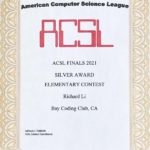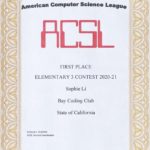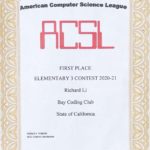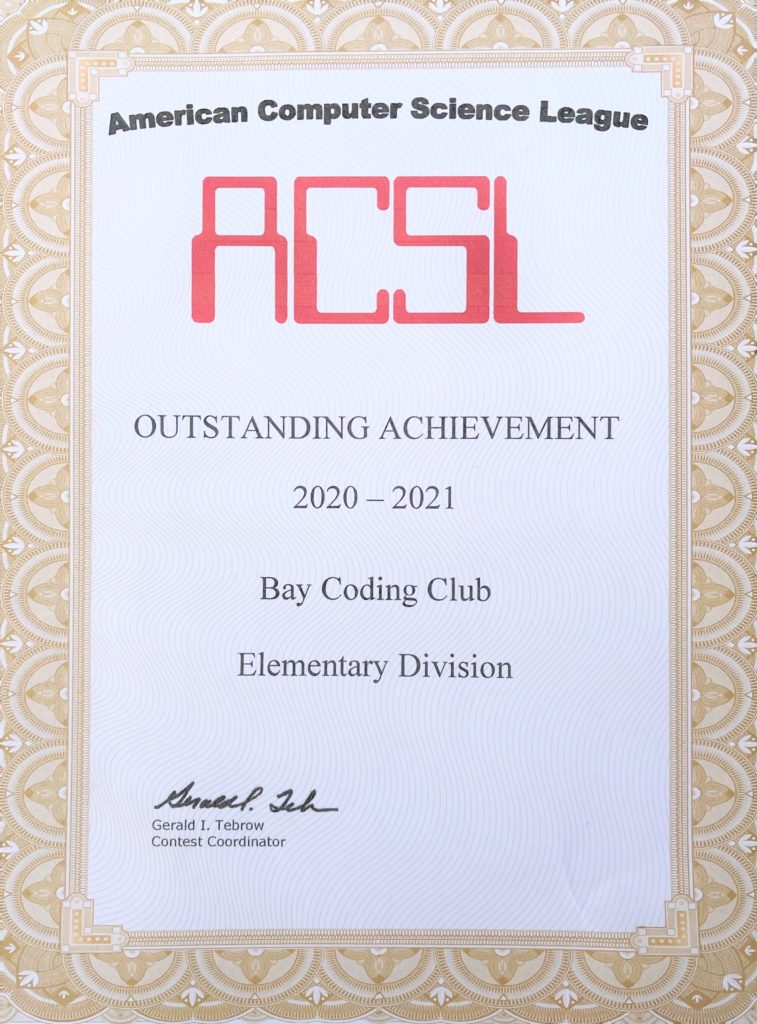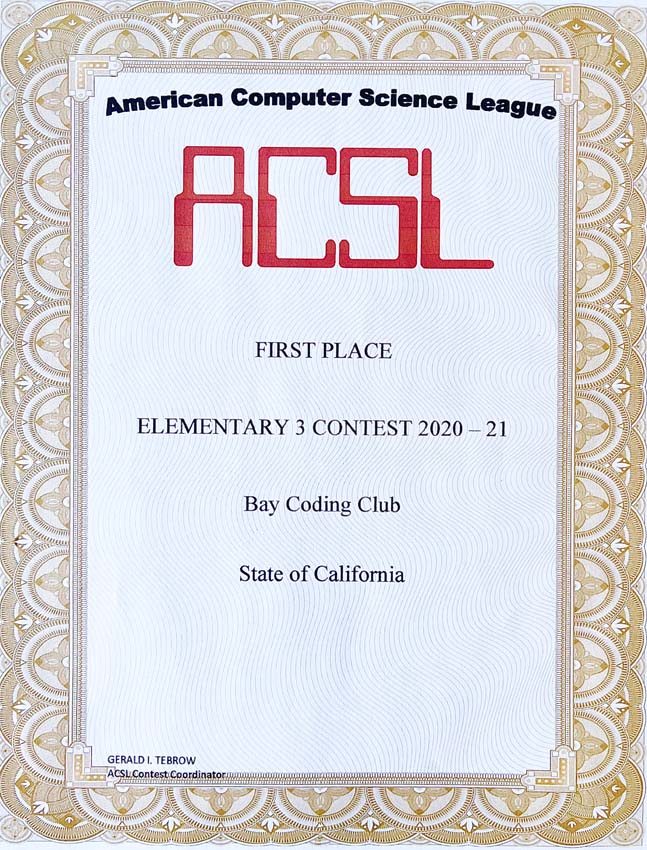American Computer Science League
ACSL Team Contests
Please note that you have to attend ALL the first four competitions to be qualified for the FINAL one.
We support computing education worldwide by identifying, motivating, and training computing students at all levels.
The training classes are open to all registered students. Please note that an Junior team entry EVALUATION is required for being a team member for the Junior contest team. Elementary team dose not need the evaluation. The evaluation test question will be provided by the coach. Feel free to contact us by sending an email to info@baycodingclub.com or call
650-254-6886.

Based on the scores during the regular season, top students in all divisions will be invited to participate in an online Finals competition:
- Invitations E-mailed: May 1, 2024 through May 16, 2024
- Invitational Finals: Saturday, May 25, 2024 (Memorial Day weekend in the United States)
ACSL offers multiple divisions, providing an appropriate challenge for students of varying ages and abilities. An unlimited number of students may compete in each contest.
Each season is divided into four contests, testing students on fundamental concepts in computer science, ranging from Number Systems to Boolean Algebra to Digital Electronics. In the upper divisions, each contest also includes a problem to solve by programming using Python, C++ or Java.
Contests are administered online. Team advisors facilitate students’ access to the online platform; the platform corrects the submissions and reports the scores to ACSL. Online resources assist advisors to prepare their students for each competition. Each topic on the Study Materials page is linked to the page of the ACSL Wiki that describes the topic in detail.
At the end of the year, the top students are invited to compete in an online Finals competition.
Topics
- Contest 1: Number systems, bases.
- Contest 2: Prefix/Infix/Postfix math notation (i.e. representing math in the form). Students need to understand order of operations.
- Contest 3: Boolean algebra.
- Contest 4: Graph theory.
- Final Contest: An individual contest. Invitation only if the participant is qualified based on the results of previous 4 contests.
Prerequisites
No experience needed, but only school students in Grades 3-6 can attend.
Unit 1 Mainly focus on knowledge learning in ACSL
Session 1 - 6 weeks (1.5 hours per /week /class)
Session 2 - 6 weeks (1.5 hours per /week /class)
Session 3 - 6 weeks (1.5 hours per /week /class)
Session 4 - 6 weeks (1.5 hours per /week /class)
Session 5- 6 weeks (1.5 hours per /week /class)
Session 7- 8 weeks (1.5 hours per /week /class)
Unit 2 Mainly focus on Questions Practice in ACSL
Contest 1 - 6 weeks (1.5 hours per /week /class)
Contest 2 - 6 weeks (1.5 hours per /week /class)
Contest 3 - 6 weeks (1.5hours per /week /class)
Contest 4 - 6 weeks (1.5 hours per /week /class)
Contest 7 - 8 weeks (1.5 hours per /week /class)
Final Contest - 6 weeks (invited only)
Topics
-
Contest 1:
- Number systems, bases
- Recursive functions
- Figure out what other people’s code does (written in pseudocode): Specifically, branching related
-
Contest 2:
- Prefix/Infix/Postfix math notation (see elementary)
- Bit string operations: I.e. and, or, not, lshift, rshift
- Figure out what other people’s code does, loop related
-
Contest 3:
- Boolean algebra
- Data structures: Stacks, Queues, Binary search trees, Priority queues
- Figure out what other people’s code does, array related
-
Contest 4:
- Graph theory
- Logic gates
- Figure out what code does - strings
- Final Contest: An individual contest. Invitation only if the participant is qualified based on the results of previous 4 contests.
Prerequisites
Pre-Assessment needed, and open to school students in Grades 3-9. Contact us before your enrollment.
Unit 1 -Mainly focus on knowledge learning in ACSL
Session 1 - 6 weeks (1.5 hours per /week /class)
Session 2 - 6 weeks (1.5 hours per /week /class)
Session 3 - 6 weeks (1.5 hours per /week /class)
Session 4 - 6 weeks (1.5 hours per /week /class)
Session 5- 6 weeks (1.5 hours per /week /class)
Session 7- 8 weeks (1.5 hours per /week /class)
Unit 2 -Mainly focus on Questions Practice in ACSL
Contest 1 - 6 weeks (1.5 hours per /week /class)
Contest 2 - 6 weeks (1.5 hours per /week /class)
Contest 3 - 6 weeks (1.5 hours per /week /class)
Contest 4 - 6 weeks (1.5 hours per /week /class)
Contest 7 - 8 weeks (1.5 hours per /week /class)
Final Contest - 6 weeks (invited only)
Please note that you have to attend ALL the first four competitions to be qualified for the FINAL one. It is too challenging to take from the 2nd competition as you have to get a full score in every contest. There is no chance to attend the FINAL competition if you join from the 3rd one because you can not earn enough scores for the qualifying.
Students compete as Teams in the regular season:
- A team can enter the 3 person division, or the 5 person division.
- Teams can have as many people as they want
- In the 3 person division the top 3 scores from the team are counted
- In the 5 person division the top 5 scores from the team are counted
- Team scores show up on a leaderboard.
Contest Format:
- Contests are delivered remotely, using Hacker Rank for Work, which is normally used for interviewing programming candidates
- Format depends on division
- Junior, Senior, Intermediate:
- 30-minute, 5 question short answer quiz (non programming)
- One programming problem to solve in 72 Hours
- Elementary:
- 30-minute, 5 question short answer quiz (non programming)
- No programming question.
ABOUT ACSL
The ACSL, or the American Computer Science League, is an international computer science competition among more than 300 schools. Originally founded in 1978 as the Rhode Island Computer Science League, it then became the New England Computer Science League. With countrywide and worldwide participants, it became the American Computer Science League. It has been in continuous existence since 1978. Each yearly competition consists of four contests. All students at each school may compete but the team score is the sum of the best 3 or 5 top scores. Each contest consists of two parts: a written section (called “shorts”) and a programming section.Written topics tested include “what does this program do?”, digital electronics, Boolean algebra, computer numbering systems, recursive functions, data structures (primarily dealing with heaps, binary search trees, stacks, and queues), lisp programming, regular expressions and Finite State Automata, bit string flicking, graph theory, assembly programming and prefix/postfix/infix notation.
How many Divisions in ACSL? There are five divisions in ACSL: Elementary, Classroom, Junior, Intermediate, and Senior. The Elementary Division is a non-programming competition for grades 3 – 6. It tests one topic per contest. The Classroom Division is a non-programming competition for all grades and consists of a 10 question test on 4 topics each contest. Junior Division is recommended for middle school students (no students above the ninth grade may compete in it). Intermediate and Senior Divisions are for secondary school students, Intermediate being easier and Senior being more difficult.At the All-Star Contest, the Junior teams consist of 5 members each while the Senior and Intermediate teams can consist of 3 or 5 members. Each team competes against other same-sized teams in its division.
Regular Season in ACSLThe Regular Season, in which individual students compete to get their school team qualified for the All-Star Contest, consists of four rounds. These rounds consist of a programming part and a written part. In the programming part, students have 72 hours to complete a program in any computer language to perform the given task. In the written part, students have a total of 30 minutes to answer 5 questions based on given topics. Students then receive a score of up to 10 points (5 for written and 5 for programming). For the Classroom Division, students receive 45 minutes to solve 10 written problems. For the Elementary Division, students have 30 minutes to solve 5 written problems. Prizes are awarded to top scoring teams and students based upon cumulative scores after the fourth contest.


